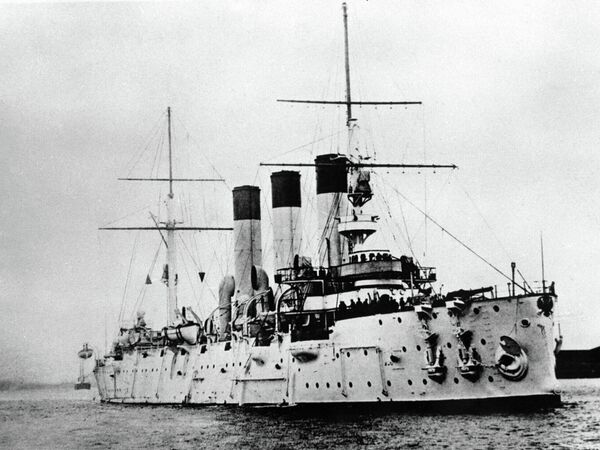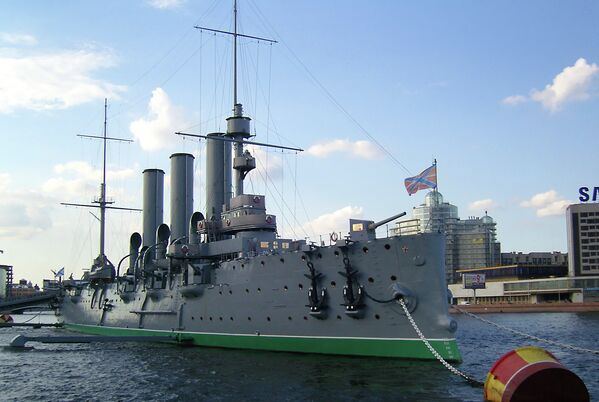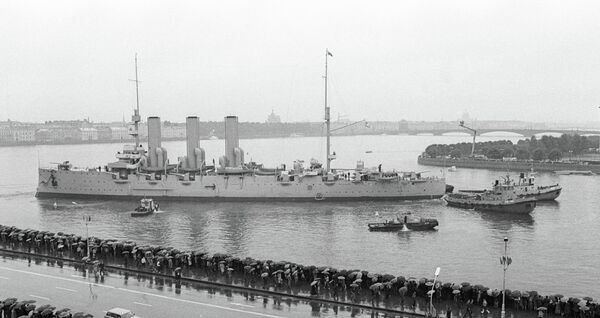On May 11, 1900 a ship was christened out in St. Petersburg. That ship was destined to change the course of history with a single shot, and that ship's name is Aurora.

Three protected Russian Pallada-class cruisers Aurora, Diana and Pallada were touted as the next step in the naval arms race at the dawn of the 20th century.
Above: The Avrora cruiser before launch. November 11, 1900.
Above: The Avrora cruiser before launch. November 11, 1900.

Aurora was christened on the Neva River before the eyes of the Russian Emperor Nicholas II on May 11, 1900.
Above: Cruiser Aurora. September 1, 1904.
Above: Cruiser Aurora. September 1, 1904.

The three ships were designed to serve in the Russian Far East.
Above: Visitors on the cruiser Aurora ladder.
Above: Visitors on the cruiser Aurora ladder.

Aurora was a 126,8-meter-long cruiser with displacement of 6,731 tons. Its armament originally included artillery guns and torpedoes.
Above: Sailors scrubbing the Aurora cruiser deck. September 4, 1967.
Above: Sailors scrubbing the Aurora cruiser deck. September 4, 1967.

In November 1903, Aurora was ordered to move to the Far East to reinforce the Russian Pacific Fleet.
Above: The Aurora cruiser radio station. August 16, 1970.
Above: The Aurora cruiser radio station. August 16, 1970.

The cruiser participated in the Russo-Japanese War (February 9, 1904 – September 5, 1905).

During the Battle of Tsushima in May 1905, Aurora covered slower Russian ships and managed to break out and reach neutral Manila.

8/15
© AP Photo / Dmitry Lovetsky
The cruiser returned to Russia in 1906 and became a cadet training ship in the Baltic Sea.
Above: Naval cadets lower the flag of the navy cruiser Aurora at a daily ceremony near the front deck gun in St.Petersburg, January 26, 2012, with the St. Isaak's Cathedral seen on the background.
Above: Naval cadets lower the flag of the navy cruiser Aurora at a daily ceremony near the front deck gun in St.Petersburg, January 26, 2012, with the St. Isaak's Cathedral seen on the background.

The vessel was repaired and its armament was changed.
Above: Restored cruiser Aurora enters Neva waterway.
Above: Restored cruiser Aurora enters Neva waterway.

Aurora participated in World War I patrolling the Baltic Sea.
Above: Museum ship, the cruiser Aurora, is towed along the Neva River in St. Petersburg on September 21, 2014.
Above: Museum ship, the cruiser Aurora, is towed along the Neva River in St. Petersburg on September 21, 2014.

In 1917, after the February Revolution, the most of Aurora’s crew joined the Bolsheviks and a revolutionary committee was formed on the ship.
Above: Aurora cruiser sailors in the streets of Petrograd, October of 1917.
Above: Aurora cruiser sailors in the streets of Petrograd, October of 1917.

Aurora’s finest hour occurred on October 25. A shot from its forecastle gun served as a signal for storming the Winter Palace in Petrograd, which was the beginning of the October Socialist Revolution in Russia. Most historians believe that the shot was blank.

During the Great Patriotic War, German troops hunted Aurora as a symbol of the Soviet Union. But the ship survived all air raids.

Currently Aurora, one of the symbols of the Russian history, is stationed in St. Petersburg and serves as a museum.
Above: Museum ship, the cruiser Aurora, is towed along the Neva River in St. Petersburg on September 21, 2014.
Above: Museum ship, the cruiser Aurora, is towed along the Neva River in St. Petersburg on September 21, 2014.

Aurora gained a broad reflection in culture. It is the subject of songs and movies, and appeared on coins and stamps in different countries.
Above: Russian Navy sailors stand in front of the Aurora cruiser during a Navy Day parade rehearsal on Neva River in St. Petersburg, July 29, 2011.
Above: Russian Navy sailors stand in front of the Aurora cruiser during a Navy Day parade rehearsal on Neva River in St. Petersburg, July 29, 2011.

